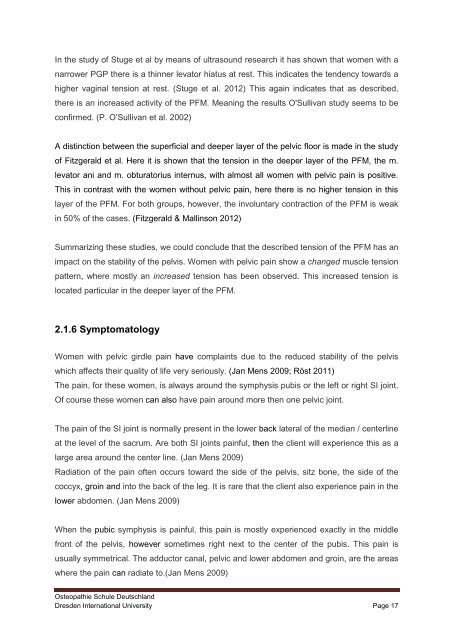Pelvic girdle pain and relevance of ASLR testing: A ... - Cindy Verheul
Pelvic girdle pain and relevance of ASLR testing: A ... - Cindy Verheul
Pelvic girdle pain and relevance of ASLR testing: A ... - Cindy Verheul
Create successful ePaper yourself
Turn your PDF publications into a flip-book with our unique Google optimized e-Paper software.
In the study <strong>of</strong> Stuge et al by means <strong>of</strong> ultrasound research it has shown that women with a<br />
narrower PGP there is a thinner levator hiatus at rest. This indicates the tendency towards a<br />
higher vaginal tension at rest. (Stuge et al. 2012) This again indicates that as described,<br />
there is an increased activity <strong>of</strong> the PFM. Meaning the results O'Sullivan study seems to be<br />
confirmed. (P. O’Sullivan et al. 2002)<br />
A distinction between the superficial <strong>and</strong> deeper layer <strong>of</strong> the pelvic floor is made in the study<br />
<strong>of</strong> Fitzgerald et al. Here it is shown that the tension in the deeper layer <strong>of</strong> the PFM, the m.<br />
levator ani <strong>and</strong> m. obturatorius internus, with almost all women with pelvic <strong>pain</strong> is positive.<br />
This in contrast with the women without pelvic <strong>pain</strong>, here there is no higher tension in this<br />
layer <strong>of</strong> the PFM. For both groups, however, the involuntary contraction <strong>of</strong> the PFM is weak<br />
in 50% <strong>of</strong> the cases. (Fitzgerald & Mallinson 2012)<br />
Summarizing these studies, we could conclude that the described tension <strong>of</strong> the PFM has an<br />
impact on the stability <strong>of</strong> the pelvis. Women with pelvic <strong>pain</strong> show a changed muscle tension<br />
pattern, where mostly an increased tension has been observed. This increased tension is<br />
located particular in the deeper layer <strong>of</strong> the PFM.<br />
2.1.6 Symptomatology<br />
Women with pelvic <strong>girdle</strong> <strong>pain</strong> have complaints due to the reduced stability <strong>of</strong> the pelvis<br />
which affects their quality <strong>of</strong> life very seriously. (Jan Mens 2009; Röst 2011)<br />
The <strong>pain</strong>, for these women, is always around the symphysis pubis or the left or right SI joint.<br />
Of course these women can also have <strong>pain</strong> around more then one pelvic joint.<br />
The <strong>pain</strong> <strong>of</strong> the SI joint is normally present in the lower back lateral <strong>of</strong> the median / centerline<br />
at the level <strong>of</strong> the sacrum. Are both SI joints <strong>pain</strong>ful, then the client will experience this as a<br />
large area around the center line. (Jan Mens 2009)<br />
Radiation <strong>of</strong> the <strong>pain</strong> <strong>of</strong>ten occurs toward the side <strong>of</strong> the pelvis, sitz bone, the side <strong>of</strong> the<br />
coccyx, groin <strong>and</strong> into the back <strong>of</strong> the leg. It is rare that the client also experience <strong>pain</strong> in the<br />
lower abdomen. (Jan Mens 2009)<br />
When the pubic symphysis is <strong>pain</strong>ful, this <strong>pain</strong> is mostly experienced exactly in the middle<br />
front <strong>of</strong> the pelvis, however sometimes right next to the center <strong>of</strong> the pubis. This <strong>pain</strong> is<br />
usually symmetrical. The adductor canal, pelvic <strong>and</strong> lower abdomen <strong>and</strong> groin, are the areas<br />
where the <strong>pain</strong> can radiate to.(Jan Mens 2009)<br />
Osteopathie Schule Deutschl<strong>and</strong><br />
Dresden International University Page 17


